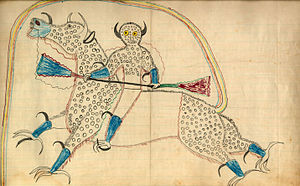Black Hawk (Artist)
Black Hawk (* around 1832; † after 1889) was a spiritual leader ( medicine man ) of the Sans Arc or Itázipčho tribe of the Lakota . He was particularly well known as an artist. He drew 76 colored graphics ( Ledger Art ) about the Lakota life as well as about his spiritual visions. His drawings are considered the most complete collection of Lakota art in the early reservation period and unique historical and cultural documents.
The Black Hawk tribe, the Sans Arc, were one of seven tribes of the Lakota, a nomadic group of plains Indians who followed the large herds of buffalo. The buffalo represented everything they needed to live: food, clothing and tarpaulin for the tipis. At that time, the herds were almost wiped out, mainly by the growing number of white settlers, and the prairie Indians were driven into reservations where living conditions were very difficult.
In the severe winter of 1880/1881, Black Hawk struggled to support his family on the Cheyenne River Indian Reservation . He therefore accepted an offer from William Edward Cato, the reservation's Indian trader , to produce graphics for a fee. Black Hawk received 50 cents from Caton for each drawing, for a total of $ 38, which was a significant amount for the time. In 1994, Black Hawk's Ledger Art book was auctioned for $ 400,000 to a private collector.
Little is known about Black Hawk's life after 1889. It is believed that he was killed in the Wounded Knee Massacre of 1890, but that is not certain.
See also
Individual evidence
- ↑ a b c d e Janet Catherine Berlo: Spirit Beings and Sun Dancers: Black Hawk's Vision of the Lakota World . George Braziller in association with the New York State Historical Association, New York, NY 2000, ISBN 0-8076-1465-3 .
Web links
- Drawing on Tribal History by Inga Kiderra.
- Black Hawk Ledger , a virtual gallery of Black Hawk's drawings.
| personal data | |
|---|---|
| SURNAME | Black Hawk |
| ALTERNATIVE NAMES | Itázipčho |
| BRIEF DESCRIPTION | native american artist |
| DATE OF BIRTH | around 1832 |
| DATE OF DEATH | after 1889 |

